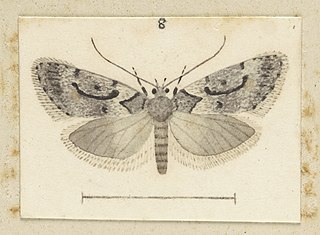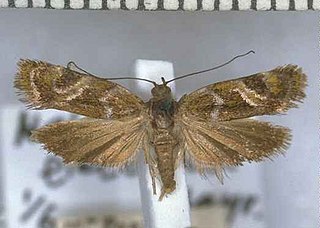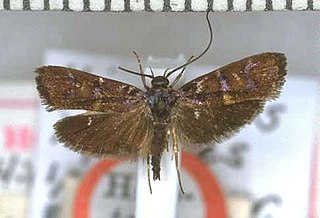
Tingena armigerella is a species of moth in the family Oecophoridae. T. armigerella is endemic to New Zealand where it is found in the North Island. The larvae of this species feed on plant litter. It is parasitised by the parasitic wasp Fustiserphus intrudens.

Zealandopterix zonodoxa is a moth of the family Micropterigidae. It is endemic to New Zealand and is located from Hawkes Bay north as well as on Poor Knights, Little Barrier and the Great Barrier Islands. It is the smallest micropterigid in New Zealand and the shiny white markings on the forewing of this species display variation. It is a moth that is active during the day, but has been collected using UV light. Adults are on the wing from September to March and the species has been witnessed visiting the flowers of Nīkau and Cordyline pumilio in large numbers. It inhabits a wide variety of moist indigenous forest but is associated with forests in which podocarps are common. Larvae have been sieved from rotten wood on the floor of a mixed podocarp/broadleaf forest or extracted from moss or from bryophytes.

Izatha manubriata is a moth of the family Oecophoridae. It is endemic to New Zealand, where it is known from the southern South Island only.

Izatha rigescens is a species of moth in the family Oecophoridae. It is endemic to New Zealand. This species is classified as having the conservation status of "Data Deficient" by the Department of Conservation. It is only known from the Wellington coast. This species has not been seen since 1929.

Batrachedra filicicola, also known as the ring fern spore-eater, is a species of moth of the family Batrachedridae. It is endemic to New Zealand and has been collected in the North Island. The larvae of this species feed on the spores of the silver fern. Adults are on the wing in November and December. This species is attracted to light and has also been collected in the day by sweeping silver fern fonds.

Phycomorpha metachrysa, the milktree fruit moth, is a species of moth in the Copromorphidae family. It is endemic to New Zealand and has been found in the North and South Islands. The larvae feed on the fruit of species in the genus Streblus including Streblus heterophyllus. This adults of this species is on the wing from October to April.
Petasactis is a genus of moths belonging to the family Tineidae. It contains only one species, Petasactis technica, which is endemic to New Zealand. This species has not been collected since prior to 1888. It is classified as "Data Deficient" by the Department of Conservation.

Pasiphila plinthina is a moth in the family Geometridae. It is endemic to New Zealand and is found in both the North, South and Stewart Islands. It is on the wing mainly from June until September with occasional observations up to December, and is attracted to light. This species is similar in appearance to P. sandycias but can be distinguished from it as P. plinthina has palpi that are longer and has more blurred forewing markings.

Physetica prionistis is a moth of the family Noctuidae. It was described by Edward Meyrick in 1887. It is endemic to New Zealand and is widespread throughout the North, South and Chatham Islands. This species can be found in open clearings of shrubland and forest at altitudes from sea level up to the alpine zone. Adults are on the wing throughout the year and are attracted to sugar traps and occasionally to light. The life history of this species is unknown as are the larval host species.

Hierodoris illita is a moth of the family Oecophoridae. It is endemic to New Zealand and is found in both the North and South Islands. However this species has not been recorded at Stewart Island / Rakiura.

Hierodoris electrica is a moth of the family Oecophoridae. It was described by Edward Meyrick in 1889. It is endemic to New Zealand, where it has been reported from the northern and southern parts of the South Island. The larva of H. electrica has yet to be described. The wingspan is between 15 and 16.5 mm. The ground colour of the forewings is dark brown, with narrow yellow scales overlaying this base colour. The hindwings are brown. The known larval host species is Olearia nummulariifolia.

Eudonia zophochlaena is a moth in the family Crambidae. It was described by Edward Meyrick in 1923. It is endemic to New Zealand. It has been hypothesised that this species is a North Island endemic. The adults of this species are on the wing from December until February. The larvae of this species are leaf miners of the leather-leaf fern Pyrrosia eleagnifolia.

Hierodoris iophanes is a moth of the family Oecophoridae. It was described by Edward Meyrick in 1912. This species can be distinguished from others in its genus by the purple metallic colouration as well as the blue-white mark on its forewings. It is endemic to New Zealand, where it has been recorded from Auckland to Southland. This species inhabits native forest or scrub, with the adults preferring open glades. They are known to be on the wing from November until February and fly during daylight hours, being active on hot sunny days. Larvae feed on the interior of twigs of Prumnopitys ferruginea. The twigs had evidence of oviposition scars of cicadas and the larvae were collected in October after reddish-brown frass indicated their location within the twigs.

Sporophyla oenospora is a species of moth in the family Pyralidae. It is endemic to New Zealand. It is classified as critically endangered by the Department of Conservation.

Xanthorhoe lophogramma is a species of moth in the family Geometridae. It is endemic to New Zealand and if found in the South Island. This species inhabits dry beech scrub but its larval host is unknown. Adult moths are on the wing in January. This species is classified as "At Risk, Nationally Uncommon" by the Department of Conservation.

Notoreas atmogramma is a species of moth in the family Geometridae. This species is endemic to New Zealand. It is a day flying moth that frequents alpine habitat.

Notoreas chrysopeda is a species of moth in the family Geometridae. This species is endemic to New Zealand. It is a colourful day flying moth that lives in mountainous habitat.
Ichneutica theobroma is a moth of the family Noctuidae. This species is endemic to New Zealand. The males of this species has a pink chocolate brown appearance to its forewings with a small white dot. The males of this species can be distinguished from the 'northern dark form' of Ichneutica arotis as they have broader shaped forewings with less markings than the latter species. The females are extremely difficult if not impossible to tell apart. I. theobroma are found in the northern parts of the North Island and inhabit kauri forests. The life history of this species is unknown as are the host species of its larvae although it has been hypothesised that larval hosts include Gahnia setifolia and Gahnia xanthocarpa. Adults of this species are on the wing from mid September until early November and are attracted to light.
Physetica funerea is a species of moth of the family Noctuidae. It is endemic to New Zealand and is found only in the western and central parts of the South Island. This species inhabits shrubland in the subalpine and alpine zones. The life history of this species is unknown as are the larval host species. Adults of this species are on the wing from October to February. This species is almost identical to P. cucullina with the only difference between the two species being the structure of the male antennae. P. funerea is also similar in appearance to P. sequens, but the latter species tends to have a prominently underlined kidney-shaped mark nearer to the outer edge of the forewing.

Hierodoris callispora is a moth of the family Oecophoridae. It is endemic to New Zealand and can be found throughout the country from south of the Bay of Plenty. This species inhabits native beech forest. Adults of the species have been found where Muehlenbeckia is common. Adults have also been collected from the flowers of Kunzea ericoides. However the larval host is unconfirmed although it has been hypothesised that larvae of this species feed on Kunzea ericoides flowers. Adults of this species can be distinguished by its orange ruff that contrasts with its dark head and thorax. There is a colour form that exists that has orange scales and an orange coloured fringe on the hindwing. Adults have been collected in December and January and are day flying but are also attracted to light at night. A female specimen has been found with a larva in her oviduct suggesting that this species may give birth to larval young.





















